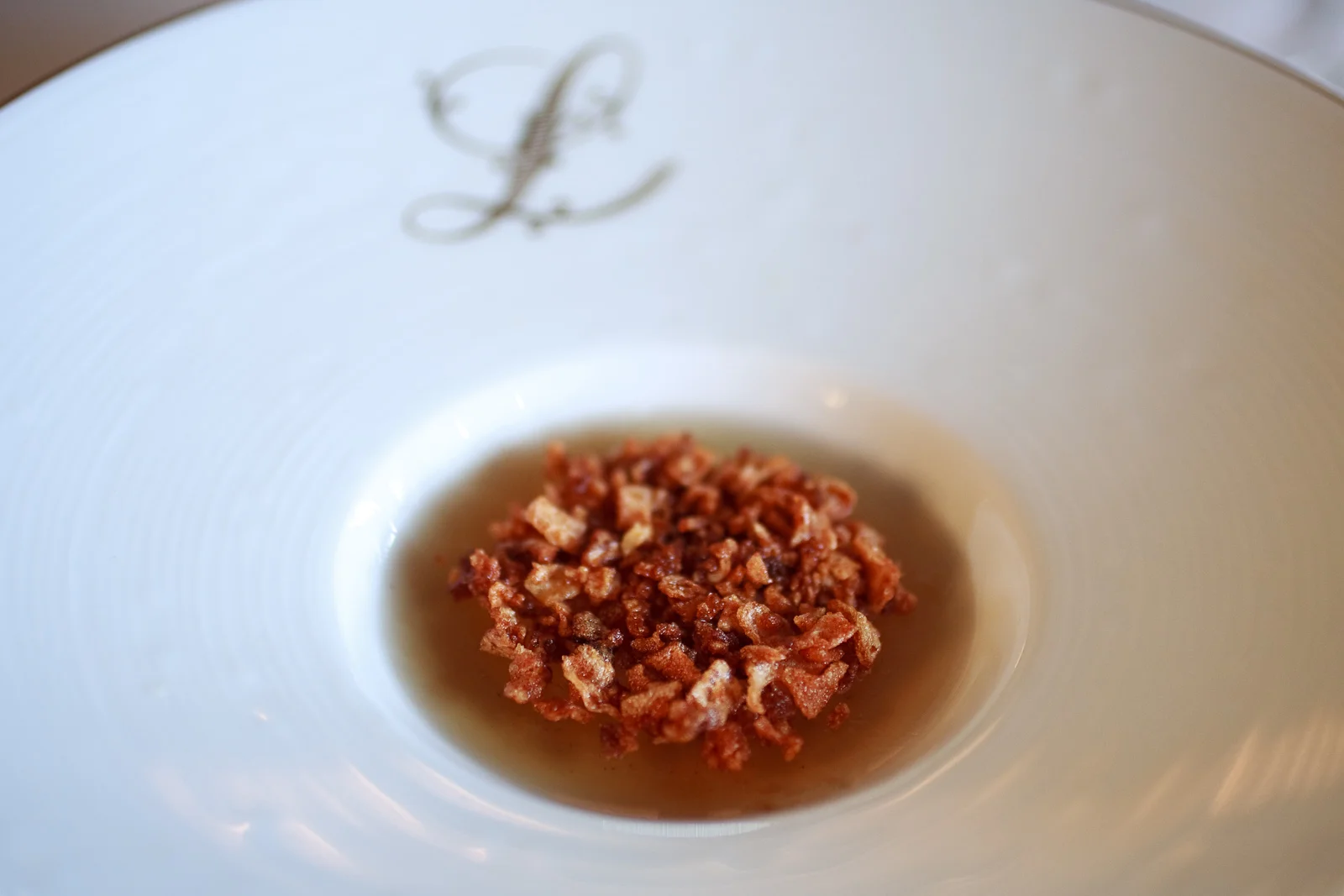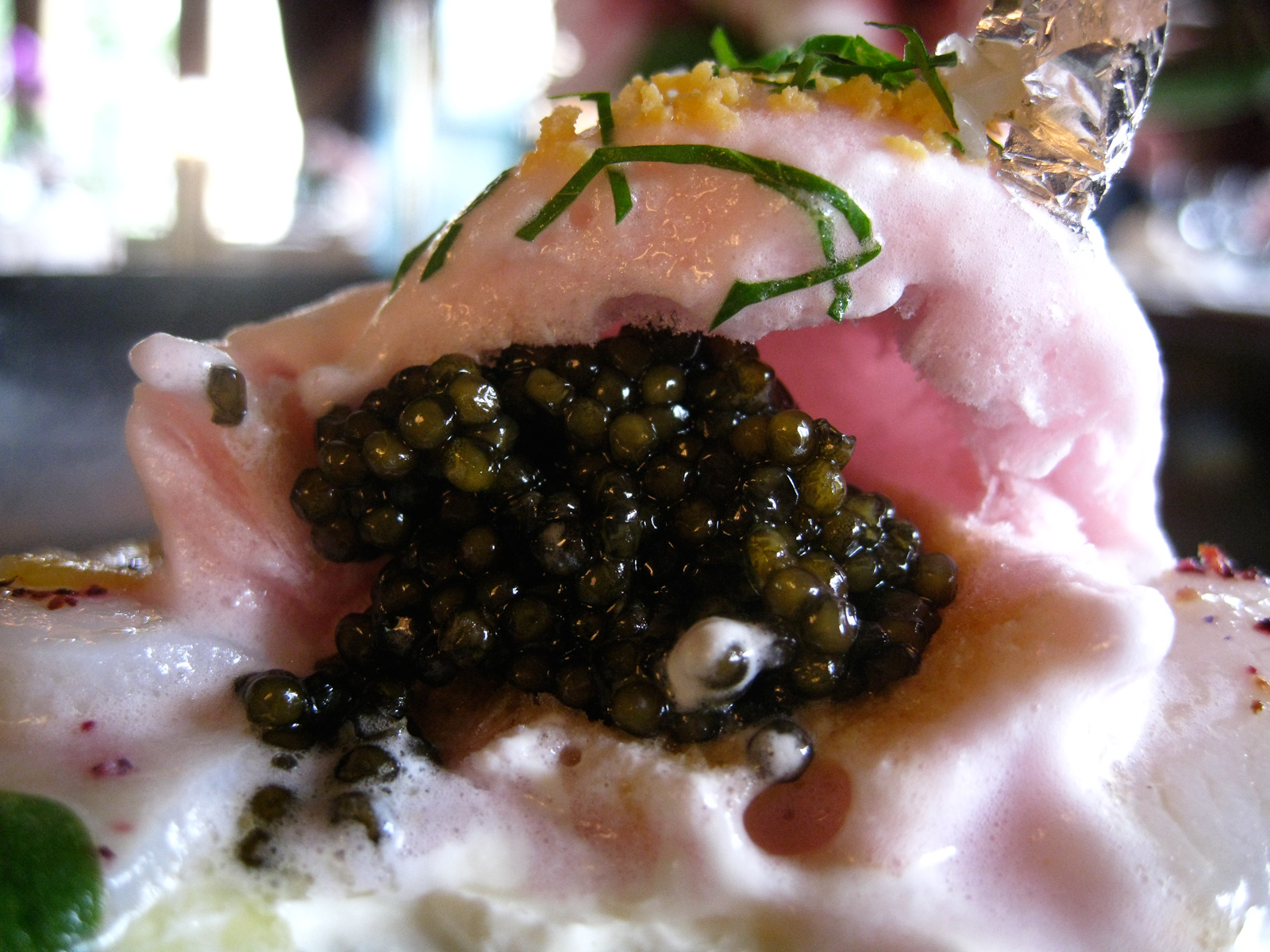Ledoyen
When I was little I remember hearing of "French dining," a term that, to me, meant dressing up fancy and sitting quietly for a bombardment of heavy butter-based sauces used indiscriminately for both fish and meat. Not that there's anything wrong with that, per se. But when a country like France has such an established tradition of fine dining, it can be difficult to respect and learn from such convention while remaining innovative and novel. Precious few restaurants in Paris are able to naturally build off of French culinary tradition while still producing dishes that are creative, avant-garde, and most importantly, delicious. Choosing one's place along this culinary spectrum is no simple task. So imagine my curiosity when I learned that Christian Le Squer's Ledoyen had been in existence since 1792, the same year that Louis XVI was arrested and taken into custody. Yet unlike Louis, it seems that Ledoyen had luck on its side. Despite being over two hundred years old, Ledoyen has been able to bridge tradition and innovation creating interesting and tasteful dishes while still paying homage to the incredible institution that is French fine dining.
The restaurant itself is located in the Pavillion Ledoyen just off the Champs Élysées in Paris' 8th arrondissement. Being on the second floor, the restaurant has an incredible view of the Petit Palais and the surrounding park. I went towards the end of fall, which meant I was surrounded by uncountable trees of yellow, red, and orange leaves; the foliage was stunning. The floor to ceiling windows certainly helped. There were no crystal chandeliers, baroque paintings or gold-leafed molding here. The dining room was classic and understated, formal yet full of daylight. I sat in the corner with a bird's eye view of both the restaurant and the changing of seasons around me.
The waiter brought out a slate of four amuses bouche: a foie gras macaron, herb croquettes with liquid foie gras, a foie gras puff pastry, and spherified cheese. The meringue shell of the macaron was crunchy which while not evocative of macarons at Ladurée, was appreciated since the foie was so creamy. The herb croquettes were wonderful, the shells of which were essentially non-existent once it entered my mouth spilling out only a warm crème of foie gras. The puff pastry too was served warm, the crispy shell of many layers adding texture to the creamy foie gras. Last were the cheese spheres whose flavor was slightly diluted, or at least it tasted that way after having eaten three prior amuses with strong flavor.
The second amuse bouche was a small bowl of bacon gelée made sweet. Interesting flavor, highlighting the sweet notes of pork. But I couldn't help but think that someone had accidentally spilled bacon bits onto my sugar cane gelée. Interesting concept; but I found the flavor not very interesting. The gelée was also very watery making it inedible without the crispy bacon. There was also a very stark textural contrast between these two ingredients making them seem out of sync with each other. Perhaps I should have waited a few minutes for the bacon to soften in the gelée.
The first course brought lamelles de noix de saint-jacques à l'osciètre royal, a generous dollop of Ossetra caviar hidden inside a frozen sea water sphere, surrounded by scallop medallions cooked so lightly they almost seemed raw. Beautiful presentation. What was interesting about this dish was the way the frozen sea water melted into a cold airy liquid that practically hissed like fresh ocean foam from an ebbing wave. This also kept the caviar chilled and refreshing. The scallops had a chewy and soft texture with a slight bounce as the tiny bands of muscle split apart with each bite. The lemon added a slight acidity to the lightly salted seawater foam making the entire dish taste fresh, clean, oceanic, and salty. The dish had no scent, which was nice since fresh shell fish really shouldn't have any. My biggest complaint about this dish, ironically, was the temperature. Everything was so cold that it became difficult to taste the differences between ingredients; I could only rely on texture. There was also only so much frozen sea water I could take. After scooping out the inside caviar and finishing the surrounding scallops, I called it a day.
A signature dish of the restaurant is the blanc de turbot de ligne juste braisé, pommes rattes truffées, a rectangular filet of zebra line caught turbot lightly braised and covered with stripes of black truffles. First off, I don't know what was going on with the potatoes but they were so interesting I just wanted to push the turbot to the side and finish them first! Milky, firm, and sticky, these potatoes absorbed the foamed butter sauce without affecting their texture. They were not starchy at all. I couldn't get enough of them. The turbot was slightly undercooked (read: perfectly cooked), producing a very welcome texture: a slight push with my fork and a new layer would slide down into the foam. It was actually a little difficult to tell by looking how the fish was cooked. Since the fish was ivory white, supple, and slightly gelatinous throughout, any translucency it might have had from being so lightly cooked was masked by the moisture of the fish itself. The fish was quite a large portion, however, and palate fatigue set in quickly. Also my eyes spotted the truffles, but my nose did not. Perhaps I went slightly out of black truffle season; regardless a poor seasonal ingredient should not have been served if it wasn't at the peak of freshness. That was disappointing. Other than that, this dish was essentially an elegant version of French soul food -- potatoes, fish filet, done.
Another Le Squer classic was the highlight course of the meal: ris de veau en brochette de bois de citronnelle, jus d'herbes, a fist-sized lobe of sweetbreads skewered with a lemongrass skewer and sailing along on a raft of roasted salsify in a sea of green herb purée. The light scent of lemongrass became immediately apparent, melding with earthy and rich scents of the herbal butter reduction. The sweetbreads had a savory buttery interior with a sweet and sticky shell (they had been marinated in soy sauce), a really nice contrast of texture. There were also crispy little bits of fried sweetbreads adding a bit of crunch to each bite. The harb sauce had a distinct acidity, possibly from vinegar, which helped to reduce the fatty mouthfeel left by the creamy sweetbreads. This was a fabulous dish for both flavor and texture.
Cheese service came next -- a cart filled with French classics. I opted for Beaufort d'Alpage, Roquefort, Epoisses, and Camembert de Normandie. The Beaufort was particularly nice because, like some gruyères, it had tiny salt crystals inside which made the cheese have some bites that were crunchy. (It's essential to bring this cheese to room temperature for those crystals to develop, I later learned when I bought some to eat at home later that week.) It was a really interesting texture. The époisses was runny, perfect to let drip onto a slice of whole grain bread.
I received my petit fours before my desserts, which terrified startled me because for a split second I thought this was it. Fortunately, more was to come. But for now I had a plate containing fresh figs sprinkled with sesame seeds, a small lemon cookie, a chocolate-filled cookie, and a marshmallow. The figs seemed particularly interesting, except this was way out of season and the flavor was unremarkable. This had real potential if the figs were sweeter. The marshmallow, meanwhile, was like a light and moist foam that melted in my mouth. It had no weight whatsoever.
Next came the official pre-dessert, a blanc manger d'oeuf à la leuvre, Le Squer's classic reinterpretation of the French classic. This dish not only impressed me, but demonstrates Le Squer's ability to make a very old dish innovative, modern, and fresh. This was delicious. Here we had yeast sorbet sitting atop sweet thin shavings of white chocolate and almond. These ingredients coated each spoonful of sorbet like coconut flakes, sticking to the surface yet remaining warm enough to melt away quickly on the tongue like snow. This dessert was light, creamy, and only slightly sweet. The flavor of the yeast sorbet was really similar to fior di latte gelato, except once in my mouth there was a slight scent of fresh bread.
The first full dessert was beautiful albeit a little dangerous. Named croquant de pamplemousse cuit et cru au citron vert, this dessert contained a layer of candied grapefruit, a layer of raw grapefruit marinated in lime, pineapple sorbet, and a covering of cold caramel. It was a really assertive, acidic citrus dessert that delicately highlights both the sweetness and bitterness that grapefruit can exhibit. Each layer on its own may not have worked; but together created a symphony of opposite flavors that were really interesting. The raw grapefruit was bitter, the candied grapefruit warm and sweet, the pineapple sorbet cold and refreshing, and the caramel crunchy. Really a beautiful combination, and certainly visually stunning. My only complaint is that the caramel roof of this bittersweet house can be very sharp. Since it's sitting atop sorbet the temperature stayed really cold even when in my mouth, so each bite split the sheet into tiny razor-sharp blades of sugar. Aside from that slight risk, the flavors were exciting.
Perhaps to close the bright citrus notes of the croquant de pamplemousse, the next course had a more muted and subtle flavor. Titled glacé de caramel fumé, pistils de chocolat, this was a chocolate dessert I really liked because the chocolate flavor was neither intense nor overbearing. Small strips of sweet chocolate nested a cylinder of smoked caramel sorbet providing a crispy texture to a smooth tube of rich frozen milk. I was very happy that this was served last as it left my palate in a sated state, neither craving anything savory nor sweet. It felt just right.
At the end of the meal I continued to sit at my corner table reflecting on what I'd just eaten. Granted, the beautiful view of autumn outside didn't exactly make me pack up my bags and run home. This was a very satisfying meal, certainly worthy of its three stars: flawless service, innovative dishes, and novel flavor combinations. I particularly liked the re-interpretation of classical dishes, such as the turbot, ris de veau, and blanc manger; it's great to see a restaurant that continues to re-invent even after having been around for over two hundred years. That being said, there were no flavors that jumped out and grabbed me by the heels -- the dishes, while innovative, were not so risky as perhaps necessary to discover combination that are jaw-droppingly delicious. In addition, there was a slightly mechanical element to the service and dishes where I had to remind myself that these plates actually came from a kitchen: lots of perfectly cut geometric shapes with lukewarm flavors.
I think my friend Chuck hit the nail on the head: the best way to maximize the experience at Ledoyen is to order à la carte and really make the kitchen work instead of getting the mid-day assembly line courses. The best way to take advantage of this type of cooking is to go with one other person, carefully order à la carte, and split the dishes to maximize variety without excessive portion sizes. At least that is what I will do the next time, and there definitely will be one, just not too soon. If I were here for only a short getaway in Paris, there are otherplaces that have tickled my fancy even more.
Ledoyen - Window Table






















